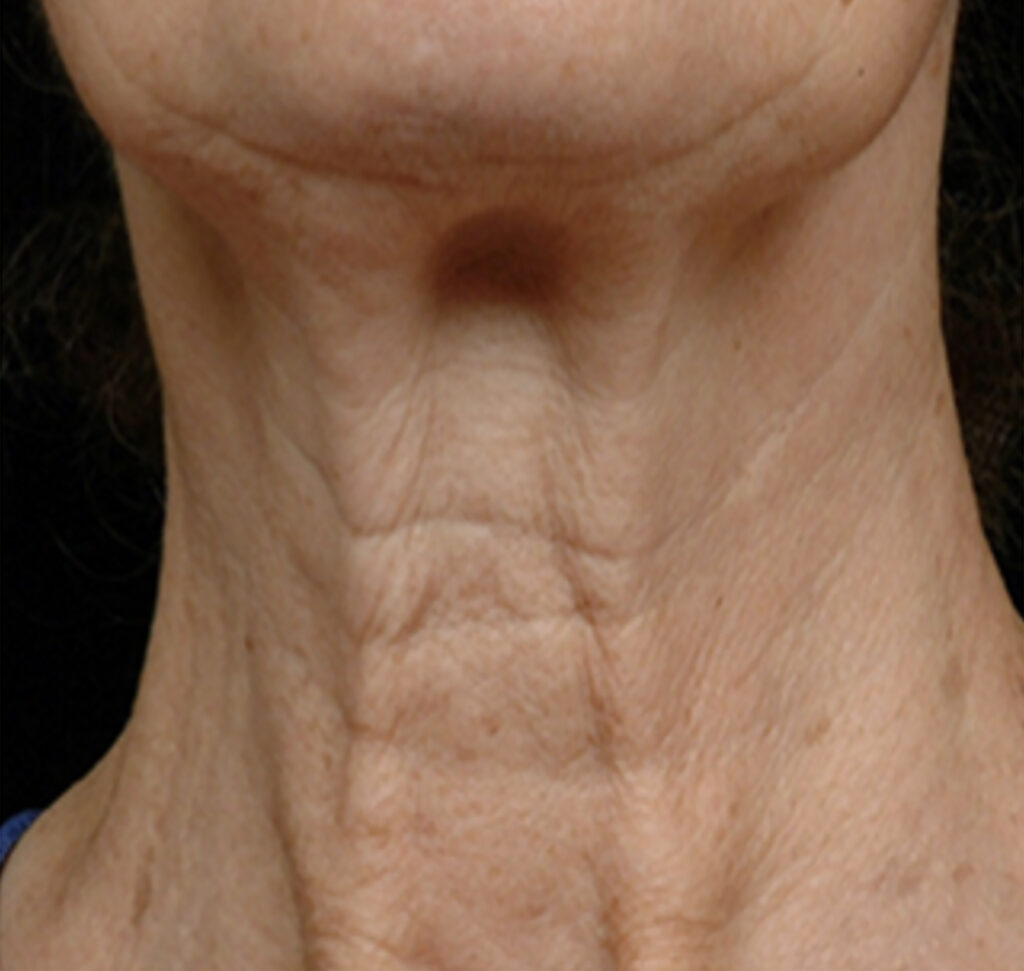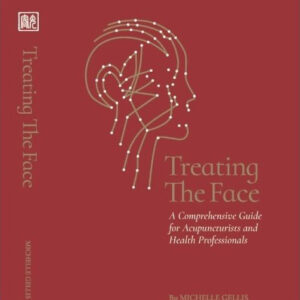Welcome to an early glimpse into my upcoming book, ‘Treating the Face: A Comprehensive Manual for Acupuncturists.’ In this excerpt, we delve into the intricate world of neck acupuncture, a realm that has traditionally posed challenges for acupuncturists. As we explore various techniques and insights, we aim to empower practitioners with the knowledge and tools to address concerns related to the neck area effectively.

Figure 4.26
Platysma Bands
Under the Chin and Jowls/Anterior Digastric
The motor point for the anterior digastric is ST-5. I like to needle into ST-5 and then thread the needle underneath the masseter, thereby using ST-5 as a motor point and taking advantage of submuscular needling of the masseter at the same time. This is a fabulous technique for lifting the jowls and treating the anterior digastric simultaneously. The anterior digastric helps support the underside of the chin. When this happens, it can result in a so-called turkey neck appearance.
For a neck as shown in Figure 4.26, submuscular needling for the anterior digastric is highly recommended. You can thread 8 to 12 needles through the bellies of the two heads of the muscle, depending on the length of the jaw. (see chapter 9)
Neck Lines and Platysma Bands/Platysma and Posterior Digastric
As we age, platysma bands and horizontal lines can form. Treating these concerns can be very difficult with acupuncture. The platysma bands are caused by the activity of the platysma muscle.21 Using a combination of submuscular needling of the platysma and the motor point for the platysma and posterior digastric, SI-17, can both tighten the muscle through its motor point and its attachment points. The platysma is a very thin muscle. It lies over the entire lower part of our jaw and it drapes down onto the clavicle.
The innervation of the platysma is the cervical branch of the facial nerve. One of its functions is to tense the neck over time. Interestingly, the cervical branch of the facial nerve, CN VII, innervates both the platysma and the posterior digastric muscle. It starts at the parotid gland and runs inferior and anterior to the platysma. The motor point for the posterior digastric and the platysma is SI-17. The motor point is found just behind the angle of the mandible and just in front of the sternocleidomastoid (SCM).
Decade of the Skin
Most of my patients come to see me when they’re in their 50s, sometimes referred to as the decade of the skin. That’s when you start to notice fine lines, wrinkles, and sagging, especially under the neck. Nora Ephron wrote a book entitled I Feel Bad About My Neck.22 When I was in my 40s, I found this book hilarious. When I turned 50, it wasn’t so funny anymore. As we age, skin becomes more lax, the hormones that keep our skin plump decreases, and we lose our estrogen (both men and women have estrogen), causing thinning skin and discoloration.
Patient Awareness
In addition to facial expressions that cause wrinkles, other factors can be major contributors to the appearance. In recent years I have noticed an increase in younger patients with horizontal lines across the front of their necks, sometimes referred to as necklace lines. These lines can be the direct result of too much computer or cell phone time. Sometimes referred to as “tech neck,” this forward head position can affect the thyroid gland, teeth, breathing, and can cause neck pain. I have seen it in individuals as young as age 18.
Posture
A forward head posture, often associated with prolonged periods of looking down at a cell phone or computer screen, can have several effects on the neck muscles, which, in turn, may contribute to neck wrinkles and face wrinkles. Here’s how this posture can impact these areas:
- Muscle imbalance: When the head consistently leans forward, the muscles at the front of the neck, such as the sternocleidomastoid and scalene muscles, can become tight and shortened. At the same time, the muscles at the back of the neck, such as the upper trapezius and suboccipital muscles, can become elongated and weakened. This muscular imbalance can contribute to poor neck posture and strain on the surrounding tissues.
- Increased tension and strain: The forward head posture places additional strain on the neck muscles and supporting structures, such as the ligaments and tendons. This increased tension can lead to muscular discomfort, stiffness, and potential trigger points that are localized knots of muscle fibers. The repetitive stress on these muscles and tissues may contribute to the development of neck wrinkles and lines.
- Compression and reduced blood flow: The forward head posture can compress the structures in the neck region, including the blood vessels and nerves. This compression can reduce blood flow to the skin and surrounding tissues, potentially impacting the delivery of oxygen and nutrients and affecting the overall health and appearance of the skin. Inadequate blood flow can contribute to skin aging and the formation of wrinkles.
- Collagen breakdown: Prolonged periods of forward head posture can lead to increased pressure on the connective tissues in the neck. Over time, this pressure can potentially contribute to the breakdown of collagen and elastin fibers, essential for skin elasticity. Reduced collagen and elastin can lead to the development of wrinkles and sagging skin in the neck and face areas.
- Altered facial expressions: The forward head posture can affect the alignment and movement of facial muscles. The strained and imbalanced neck muscles may impact the muscles of facial expression, potentially leading to changes in the way facial expressions are formed. This alteration in facial muscle dynamics can contribute to the development of wrinkles and lines on the face.
To minimize the potential impact of forward head posture on neck and facial wrinkles, it is advisable to practice proper ergonomics and posture while using electronic devices. Taking frequent breaks, adjusting the screen height, maintaining a neutral head and neck position, and incorporating neck and shoulder exercises can help alleviate muscle tension and reduce the strain on these areas.
Mouth breathing can have various effects on the face, neck, muscles, and wrinkles. A forward head posture can result in mouth breathing, as well as allergies and other sinus issues. Here are some of the unhealthy effects of mouth breathing:23
- Facial structure: Nasal breathing promotes proper development and alignment of the facial bones and structures. Chronic mouth breathing, especially during childhood, can potentially lead to a narrower upper jaw, a more elongated face, and changes in the positioning of the teeth and jaws. This can contribute to a different facial shape and appearance.
- Muscular imbalance: Breathing through the mouth requires the activation of different muscles compared with nasal breathing. The muscles in the cheeks and lips may be overused in mouth breathers while the muscles responsible for nasal breathing, such as the diaphragm and the muscles around the nose, may be underused. This muscular imbalance can potentially affect the overall facial muscle tone and contribute to a different facial appearance.
- Dryness and skin issues: Mouth breathing often leads to a reduction in saliva production and increased evaporation of moisture from the oral cavity. This can result in dry lips and dry skin around the mouth. The lack of moisture can also affect the skin’s barrier function and potentially contribute to skin issues, such as increased sensitivity, irritation, or inflammation.
- Neck and posture: Mouth breathing can affect neck and shoulder posture. When breathing through the mouth, the position of the head and neck may change as the individual tries to open up the airway. This altered posture can contribute to muscular tension, neck strain, and potential postural imbalances.
- Wrinkles and lines: Constant mouth breathing may lead to the formation of specific facial wrinkles and lines. For instance, vertical lines may develop between the nose and the upper lip (known as nasolabial folds), and the corners of the mouth may droop. Additionally, the repeated action of mouth breathing and the associated facial muscle movements can contribute to the development of wrinkles around the mouth and chin area.


